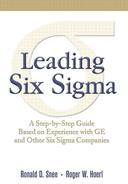GLOSSARY
- BASELINE:
The level of process performance when a project is initiated.
- BLACK BELT:
A process improvement project team leader who is trained in the Six Sigma methodology and tools and who is responsible for project execution.
- CAPABILITY:
The total range of inherent variation in a stable process. It is typically determined using data from control charts.
- CAPABILITY INDEX:
A calculated value used to compare process variation to a specification. Examples are Cp and Cpk. Can also be used to compare processes.
- CAUSE AND EFFECT (C&E):
A prioritization matrix or diagram that enables you to select those process input variables (Xs) that have the greatest effect on the process output variables (Ys).
- CONTROL PLAN:
A process control document that describes the system for controlling processes and maintaining improvements.
- COST OF POOR QUALITY:
Cost associated with poor quality products or services. Examples: product inspection, sorting, scrap, rework, and field complaints.
- CRITICAL TO QUALITY CHARACTERISTIC (CTQ):
A characteristic of a product, service, or information that is important to the customer. CTQs must be measurable in either a “quantitative” manner (i.e. 3 mg) or “qualitative” manner (i.e., correct or incorrect).
- DEFECT:
Any characteristic that deviates outside of specification limits or customer requirements.
- DESIGN OF EXPERIMENTS (DOE):
An efficient method of experimentation which identifies, with minimum testing, those factors (key process input variables) and their optimum settings that affect the mean and variation of the outputs.
- ENTITLEMENT:
The best level of performance a process can be expected to produce.
- FAILURE MODES AND EFFECTS ANALYSIS (FMEA):
Analytical approach for preventing defects by prioritizing potential problems and their resolution.
- GAGE REPEATABILITY:
The variation in measurements obtained with one measurement instrument when used several times by one analyst while measuring the identical characteristic on the same part.
- GAGE REPRODUCIBILITY:
The variation in the average of the measurements made by different analysts using the same measuring instrument when measuring the identical characteristic on the same part.
- HIDDEN FACTORY:
The part of the process that handles defective product by reworking as appropriate and scrapping what cannot be reworked to meet specification.
- MEASUREMENT SYSTEM:
The complete process used to obtain measurements. It consists of the collection of operations, procedures, gages and other equipment, software, and personnel used to assign a number or value to the characteristic being measured.
- MEASUREMENT SYSTEM ANALYSIS:
Study of the measurement system typically using Gage R&R or nested variance component studies to measure the quality (repeatability and reproducibility) of the measurement produced by the system.
- MINITAB™:
Statistical analysis software package. Widely used in Six Sigma projects.
- MULTI-VARI STUDY:
A statistical study that samples the process as it operates, and through statistical and graphical analysis, identifies the important controlled and uncontrolled (noise) variables.
- PARETO CHART:
A way to display data graphically which quantifies problems from most to least important so that the “vital few” can be identified. Named after Vilfredo Pareto, an Italian economist.
- PROCESS:
The combination of people, equipment, materials, measurements, methods, and environment that produce a given product or service. It is the particular way of doing something.
- PROCESS MAP:
A step-by-step pictorial sequence of a process showing process inputs, process outputs, and processing steps.
- PROCESS VARIATION:
The extent to which the distribution of individual values of the process characteristic (input or output variable) vary; often shown as the process average plus and minus some number of standard deviations. Other related measures of spread include the range and variance.
- MASTER BLACK BELT (MBB):
A person who is “expert” in Six Sigma techniques and project implementation. MBBs play a key role in training and coaching Black Belts.
- SIX SIGMA CHAMPION:
A business leader who facilitates the leadership, implementation, and deployment of the Six Sigma initiative and philosophies, and provides support to Black Belts and Green Belts and their projects.
- SPECIFICATION:
The engineering requirement or customer requirement for judging acceptability of a particular characteristic.
- STANDARD DEVIATION:
A measure of the spread of a process characteristic (width of the distribution).
- Xs (INPUT VARIABLES):
An independent material or element, with descriptive characteristic(s), that is either an object (going into) or a parameter of a process (step), and has a significant effect on the output of the process.
- Ys (OUTPUT VARIABLES):
A dependent material or element, with descriptive characteristic(s), that is the result of a process (step) and either is, or significantly affects, the customer's CTQ.
